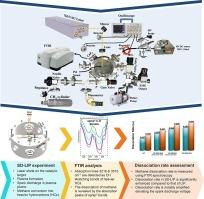Effective methane decomposition using spark discharge assisted laser-induced plasma: An approach based on Fourier transform infrared (FTIR) spectroscopy
IF 4.3
2区 化学
Q1 SPECTROSCOPY
Spectrochimica Acta Part A: Molecular and Biomolecular Spectroscopy
Pub Date : 2024-10-09
DOI:10.1016/j.saa.2024.125257
引用次数: 0
Abstract
The widespread utilization of fossil fuels cause to significantly elevate greenhouse gas emissions. Consequently, the developments of the innovative methods are essential to convert methane into the green energy. Recently, significant effort is made to enhance the performance of the plasma-based conversion technologies. Here, the dissociation rate of methane into heavier hydrocarbon compounds are carefully determined by making use of a hybrid laser-induced plasma (LIP) and spark discharge (SD). Fourier-transform infrared (FTIR) spectroscopy reveals a couple of characteristic peaks after laser triggering, whose intensities notably increase at higher applied voltages. The corresponding peaks indicate the formation of heavier compounds including sp and sp2 C–H stretching bonds. The findings elucidate that the methane decomposition rate notably elevates in favor of hybrid SD-LIP against that of traditional LIP. It is worth noting that the simultaneous ablative effect of the catalyst surface to remove the carbon soot by the successive laser shots could prevent the catalytic deactivation leading to the sustained performance.

利用火花放电辅助激光诱导等离子体有效分解甲烷:基于傅立叶变换红外光谱(FTIR)的方法
化石燃料的广泛使用大大增加了温室气体的排放量。因此,开发创新方法将甲烷转化为绿色能源至关重要。最近,人们正在努力提高基于等离子体的转换技术的性能。在这里,我们利用激光诱导等离子体(LIP)和火花放电(SD)混合技术,仔细测定了甲烷解离成较重碳氢化合物的速率。傅立叶变换红外光谱(FTIR)显示了激光触发后的几个特征峰,其强度在应用电压较高时显著增加。相应的峰值表明形成了较重的化合物,包括 sp 和 sp2 C-H 伸展键。研究结果表明,与传统的 LIP 相比,混合 SD-LIP 的甲烷分解率明显提高。值得注意的是,通过连续激光照射催化剂表面以去除碳烟的同时烧蚀作用,可以防止催化剂失活,从而实现持续的性能。
本文章由计算机程序翻译,如有差异,请以英文原文为准。
求助全文
约1分钟内获得全文
求助全文
来源期刊
CiteScore
8.40
自引率
11.40%
发文量
1364
审稿时长
40 days
期刊介绍:
Spectrochimica Acta, Part A: Molecular and Biomolecular Spectroscopy (SAA) is an interdisciplinary journal which spans from basic to applied aspects of optical spectroscopy in chemistry, medicine, biology, and materials science.
The journal publishes original scientific papers that feature high-quality spectroscopic data and analysis. From the broad range of optical spectroscopies, the emphasis is on electronic, vibrational or rotational spectra of molecules, rather than on spectroscopy based on magnetic moments.
Criteria for publication in SAA are novelty, uniqueness, and outstanding quality. Routine applications of spectroscopic techniques and computational methods are not appropriate.
Topics of particular interest of Spectrochimica Acta Part A include, but are not limited to:
Spectroscopy and dynamics of bioanalytical, biomedical, environmental, and atmospheric sciences,
Novel experimental techniques or instrumentation for molecular spectroscopy,
Novel theoretical and computational methods,
Novel applications in photochemistry and photobiology,
Novel interpretational approaches as well as advances in data analysis based on electronic or vibrational spectroscopy.

 求助内容:
求助内容: 应助结果提醒方式:
应助结果提醒方式:


